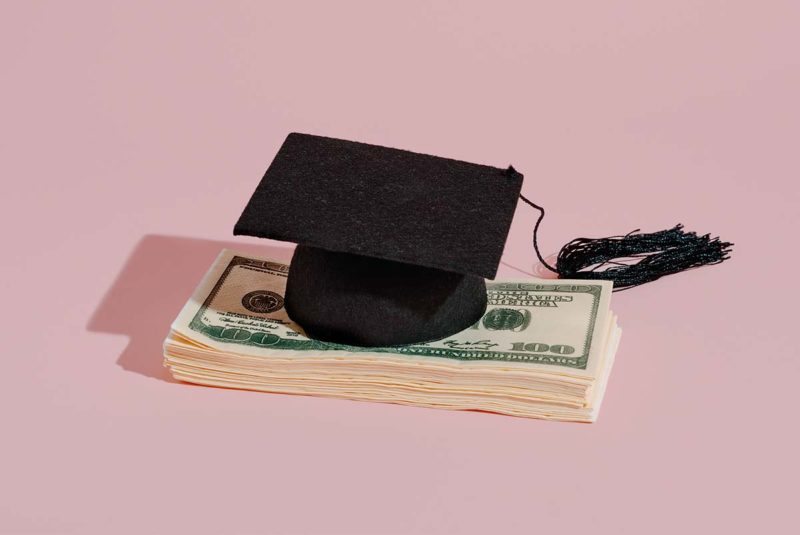Student loans can help you pay for your education when you aren’t able to pay for it all on your own. But just like any loan, they come with an interest rate that ultimately determines how much money you’ll pay over the life of your loan.
FYI: The U.S. Department of Education extended their COVID-19 emergency relief for student loans through August 31, 2023, or 60 days after the student loan debt relief program litigation is resolved.[1]
So, how do interest rates work for student loans and what is the current average student loan interest rate? We’ll cover all of that and let you know what to expect, depending on the loan you’re looking at.
How Do Student Loan Interest Rates Work?
An interest rate is the cost of borrowing money from a lender and is usually expressed as a percentage. Student loans are amortized, which means you pay the principal and interest off at the same time over the life of your loan.
No matter what type of interest rate you have, interest accrues daily. That means it’s added up over the course of each month and included with your principal balance in your monthly payment.
You can use a simple formula to calculate how much interest you can expect to pay, which can help with budgeting.
With a fixed interest rate, even though there is a set amount of interest you’ll pay over the life of a loan, as time goes on the amount of your monthly payment that goes towards interest decreases and the amount that goes towards principal increases.
With a variable rate, the interest rate changes over the life of the loan and there isn’t a set amount of interest you can expect to pay. The amount of your monthly payment that goes towards interest varies with any rate changes.
You can get two types of student loans – federal and private – and the interest rates work differently for each.
Student loan terms to know
Before we get too deep into interest rates, let’s look at a few key terms to make reading this guide a little bit easier.
- Federal Student Loan: A loan backed by the U.S. Department of Education
- Private Student Loan: A loan backed by a private lender – like a bank, credit union, online lender or other financial institution
- Subsidized Loan: A federal student loan for undergraduate students where the government pays for your interest while you’re in school, during a 6-month grace period after you leave school (when you don’t have to make payments) and during a deferment period (when you request to postpone your payments)
- Unsubsidized Loan: A federal student loan for both undergraduate and graduate students that accrues interest from the moment it is disbursed (paid out) and during a deferment period
- Parent PLUS Loan: A federal student loan that helps legal guardians pay for their dependent’s education expenses not covered by financial aid
- Grad PLUS Loan: A federal student loan that helps graduate or professional students pay for their education expenses not covered by financial aid
- Fixed interest rate: An interest rate that does not change over the life of the loan. Your payments will also stay the same
- Variable interest rate: An interest rate that can change over the life of the loan. Your payments may also change depending on the economy
Federal student loan interest rates
Federal interest rates vary depending on the type of loan and when the loan was disbursed. But they are fixed rates and usually lower than private student loans.
Interest rates are set each school year by federal law (looking at you, Congress) and not by the U.S. Department of Education. They are calculated using a formula from the Higher Education Act of 1965 (HEA) that is equal to the high yield of the 10-year Treasury notes plus a fixed add-on amount depending on the loan.[2]
Let’s look at how interest works with different federal student loans:
- Federal Direct Subsidized Loans: Interest doesn’t start accruing on your loan until 6 months after you leave school. Even though you don’t have to, you can make payments during this 6-month grace period that will go straight to your principal. After the grace period, your payments will go towards the principal and the interest that begins to accrue.
- Federal Direct Unsubsidized Loans: Interest accrues from the moment your loan is disbursed. When you leave school, you will still have a 6-month grace period before you have to begin making payments. However, interest is still accruing during that time (and while you were in school) so it’s a good idea to begin paying off unsubsidized loans as soon as you can.
- Federal Direct PLUS Loans: For both parent and grad PLUS loans, interest accrues from the moment the loan is disbursed. A grad PLUS loan offers a 6-month grace period after you leave school, but with a parent PLUS loan, you are required to begin repaying the loan as soon as it’s disbursed, unless you request a deferment.
Private student loan interest rates
Private interest rates closely follow the trends of federal interest rates. However, rates depend on things like:
- Which lender you choose
- The length of your repayment plan
- The credit score of those applying for the loan (which means you’ll see a hard credit pull on your credit report)
- Your income
- The program you’re enrolled in
- Your choice of a fixed or variable rate
The higher your credit score, the better your chances are of getting a lower interest rate. If you can’t meet the credit requirements on your own, apply with a co-signer who has a credit score that meets the lender’s requirements.
Variable rates are often lower when you first start making payments and then may rise or fall as time goes on. Because rates can change over time, you may end up paying more interest over the life of your loan with a variable rate than with a fixed rate.
Federal loan interest rates are usually lower fixed rates, and the loans have many repayment options. It’s to your advantage to try for federal loan options before you seek out a private loan.
What Is the Average Student Loan Interest Rate in 2022?
Alright, so now that you know the details on how interest rates work, let’s get into the numbers!
The average student loan interest rate depends on many factors like the loan type (federal or private), your credit score and the type of interest rate (fixed or variable).
Current federal interest rates
Federal interest rates change every school year, so let’s look at the current rates for loans that are disbursed on or after July 1, 2022, and before July 1, 2023.[3]
| Type of Loan | Type of Borrower | Current Interest Rate |
| Direct Subsidized and Direct Unsubsidized Loans | Undergraduate students | 4.99% |
| Direct Unsubsidized Loan | Graduate students | 6.54% |
| Direct PLUS Loan | Legal guardian of a dependent student and Graduate or Professional students | 7.54% |
Current private interest rates
Because private student loan interest rates vary based on so many factors, averages are where it’s at!
Right now, private student loan interest rates range from around 3% – 13%.
You may be able to get a discount on some private student loan interest rates if you select an autopay option. Talk with your lender to see if there are any other discounts you can take advantage of.
How Do I Avoid High Student Loan Interest Rates?
If you want to avoid high interest rates, or reduce your current rate, there are a few things you can do:
- Apply for a private loan with a co-signer that has a high credit score or improve your credit score before applying on your own.
- Choose a variable interest rate, which is usually lower than a fixed interest rate. But remember that the rate changes and you could end up paying more in interest than with a fixed rate.
- See if you can refinance your loans that have high interest rates, whether it’s with your current lender or with a new one.
- Consolidate your federal loans into one loan, with one interest rate, through either a Federal Direct Consolidation Loan (for federal loans only) or a private lender (for both federal and private loans).
Interest Rates for Interested Students
Here at MoneyTips, we love to keep learning. There are so many ways that you can be a student in this world and not all of them are through traditional education. But if you’re interested in going to school, you may need to get student loans through private lenders or federal student aid to help you pay for your education.
Know how interest rates work and what you can expect the current rates to be before you decide which student loan is best for you.
The Short Version
- Between federal and private student loans, the current average interest rate is approximately 5%
- Federal interest rates vary depending on the type of loan and when the loan was disbursed. But they are fixed rates and usually lower than private student loans
- Private interest rates closely follow the trends of federal interest rates. However, rates depend on things like the lender, your creditworthiness and if the rate is fixed or variable
U.S. Department of Education. “COVID-19 Emergency Relief and Federal Student Aid.”
Retrieved January 2023 from https://studentaid.gov/announcements-events/covid-19Federal Register. “Annual Notice of Interest Rates for Fixed-Rate Federal Student Loans Made Under the William D. Ford Federal Direct Loan Program.” Retrieved February 2022 from https://www.federalregister.gov/documents/2020/01/15/2020-00569/annual-notice-of-interest-rates-for-fixed-rate-federal-student-loans-made-under-the-william-d-ford#p-8
Federal Student Aid. “Federal Interest Rates and Fees.” Retrieved February 2022 from https://studentaid.gov/understand-aid/types/loans/interest-rates




